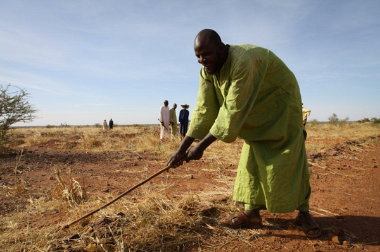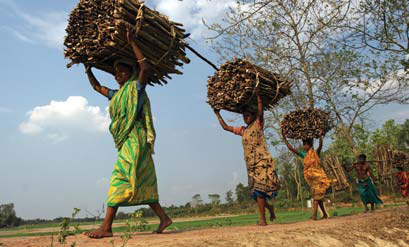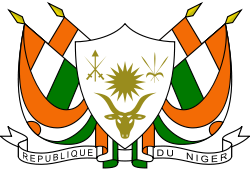Niger's Second National Communication - December 2009
Project Overview
The creation of a National Communication offers countries the opportunity to contribute with technically sound studies and information that can be used for designing mitigation and adaptation measures, and project proposals that can and will help increase their resilience to the impacts of climate change. Activities generally include: V&A assessments, Greenhouse Gas Inventory preparation, Mitigation Analysis or Education, and awareness raising activities. The ultimate goal is the integration of climate change considerations into relevant social, economic and environmental policies and actions.
Major adaptation activities presented in Niger's SNC include multi-stakeholder development and management of water resources, establishing committees for national water basins, joint-commission and multilateral bodies for trans-border waters, and the improvement of knowledge about the great fossil aquifers prior to a balanced exploitation.
Project Details
The climate in Niger is characterized by periods of greater inter-annual rainfall. Attributed to climate change, annual rainfall patterns have become increasingly erratic while total annual precipitation has decreased. This has been most clearly expressed in the increasing frequency of multi-year droughts.
Major adaptation activities presented in Niger's SNC include multi-stakeholder development and manageent of water resources, establishing committees for national water basins, joint-commission and multilateral bodies for trans-border waters, and the improvement of knowledge about the great fossil aquifers prior to a balanced exploitation.
Niger is a sahelian landlocked country whose nearest point to the sea is about 600 km. It covers a surface area of 1,267,000 sq km. It is located between the longitude 0°16’ and 16° East and the latitude 11°1’ and 23°17’ North. The three fourths of the country’s land area are occupied by deserts among which the Ténéré, one of the most wonderful deserts in the world.
The country’s economy is mainly based on agriculture and cattle breeding . Furthermore, soils are generally poor and the area potentially suitable for crop production, estimated at 15 millions hectares, represent 12% of the country’s total surface area. These lands, mainly covered by dunes, are not very productive and are sensitive to water and wind erosion.
The potential of irrigable land is estimated at 270,000 hectares of which 140,000 hectares in the river Niger valley. Niger population was estimated at 11,060,291 people in 2001 (General census, 2001). Mainly rural, the populations draw most of their incomes from natural resources exploitation.
The growth rate of the population is one of the highest in the world. It was about 3.3 % in 2001. This population growth combined with difficult climatic conditions (droughts) and inadequate and not very rational use of natural resources led to ecological imbalances expressed by the deterioration of livelihoods.
According to the trends from national statistics, the population will reach 17.3 millions by 2015 and 24.1 millions by 2025.
Key Results and Outputs
- Sustainable development and the integration of climate change concerns into medium- and long-term planning
- Inventories of anthropogenic emissions by sources and removals by sinks of greenhouse gases
- Measures contributing to addressing climate change
- Research and systematic observation
- Climate change impacts, adaptation measures and response strategies
- Education, training and public awareness
Potential Adaptation Measures
Agriculture
- Improvement through research of the genetic resistance to the desiccation of cereal varieties and improvement of farming techniques
- Effective protection of crops against harmful organisms
- Diversification and intensification of irrigated farms
- Support to the promotion of sub-urban vegetable farming
- Promotion of Income Generating Activities and the Development of Credit Unions
Livestock Production
- Support to traditional breeding through the development of pastoral facilities and securement capacities in grazing areas
- Increase the productivity of livestock by improving the genetic potential and the development of agriculture/livestock integration
- Support to village poultry farming
- Recovery of the live or dead stock value chain
- Support to the organization of the livestock value professionals
- Support to the privatization of the zoo-veterinary profession
- Fight against epizootics and setting up health intelligence
- Promotion of dairies and support to sub-urban livestock production
- Support to veterinary and zoo technical research
- Promotion of unconventional livestock production
- Support to the implementation of the action plan for the recovery of livestock production in Niger and attendant measures
Health
- Handling of endemo-epidemic climate sensitive disease cases
- Promotion of epidemic prevention and control measures
- Building the capacities of the mechanism to collect data necessary for decision-making with a view to managing climate-sensitive disease epidemics
- Introduction of an adequate research-action system likely to enable rapid and efficient decision-making
- Setting up and continuous reinforcement of an adequate biological monitoring system
- Adequate and free handling of meningitis cases
- Sensitization of the populations for the protection and prevention against climate-sensitive diseases
- Coordination of decisions and actions to epidemics at all levels
- Setting up high-performance vaccination strategies
- Setting up a communication and social mobilization system in the event of epidemics
- Systematic vaccination
Water Resources
- Knowledge and control of water resources
- Improvement of the coverage of the populations’ water needs and their living environment
- Support to all production sectors while seeking a better adequacy between costs of investments, maintenance and operation of water infrastructure
- Full participation of the populations in the design and execution of water works
- Protection of water resources and water ecosystems
- Development of water resources through a better organization of value chains
- Adequacy between water supply (for domestic, industrial, agricultural use...) and the treatment of residual water
- Adequacy between facilities disrupting water regimes
Reports and Publications
Assessments and Background Documents
Niger's Second National Communication - Official Document - December 2009
Monitoring and Evaluation
In 1992, countries joined an international treaty, the United Nations Framework Convention on Climate Change, to cooperatively consider what they could do to limit average global temperature increases and the resulting climate change, and to cope with whatever impacts were, by then, inevitable.
Parties to the Convention must submit national reports on implementation of the Convention to the Conference of the Parties (COP). The required contents of national communications and the timetable for their submission are different for Annex I and non-Annex I Parties. This is in accordance with the principle of "common but differentiated responsibilities" enshrined in the Convention.
The core elements of the national communications for both Annex I and non-Annex I Parties are information on emissions and removals of greenhouse gases (GHGs) and details of the activities a Party has undertaken to implement the Convention. National communications usually contain information on national circumstances, vulnerability assessment, financial resources and transfer of technology, and education, training and public awareness.
Since 1994, governments have invested significant time and resources in the preparation, collection and validation of data on GHG emissions, and the COP has made determined efforts to improve the quality and consistency of the data, which are ensured by established guidelines for reporting. Non-Annex I Parties receive financial and technical assistance in preparing their national communications, facilitated by the UNFCCC secretariat.




